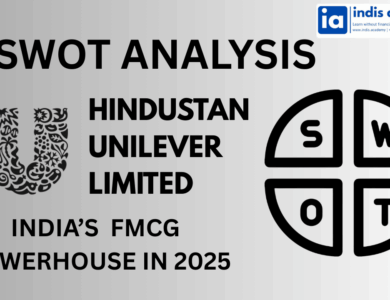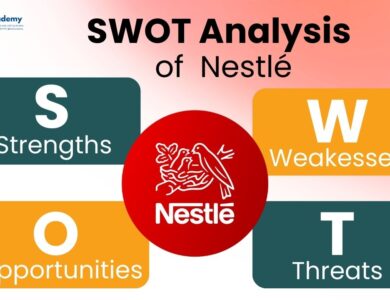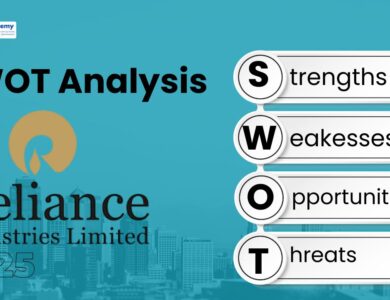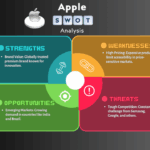SWOT Analysis of Amul: India’s Dairy Giant & Cooperative Revolution
Explore the complete SWOT analysis of Amul in 2025. Understand how India’s largest dairy brand leverages its cooperative model, brand trust, and rural reach—while facing modern retail, pricing, and supply chain challenges.
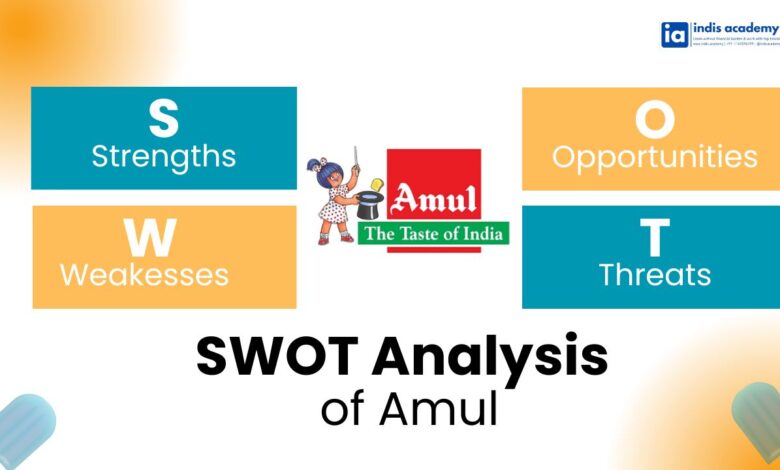
From every Indian breakfast table to international supermarket shelves, Amul is more than just a dairy brand—it’s a movement. Born from the vision of Dr. Verghese Kurien, Amul led India’s White Revolution, making the country self-sufficient in milk production and empowering millions of rural farmers through its unique cooperative model.
Fast forward to 2025, Amul is no longer just “The Taste of India”—it’s a ₹60,000+ crore FMCG force with growing ambitions in value-added dairy, bakery, and even beverages.
But the world is changing.
Consumers are turning health-conscious, urban competition is rising, and digital transformation is reshaping how food is produced, delivered, and consumed.
In this SWOT analysis, we’ll explore Amul’s core strengths, internal limitations, future opportunities, and the threats it must navigate to stay relevant in the modern FMCG landscape.
Learn AI & Digital Marketing,
Pay Fees After Placement
- ✅ Minimal Admission Fees
- ✅ No Loan or Income Sharing Agreement
- ✅ 100% Placement Support
- ✅ ISO & Govt Registered Certificate
- ✅ Practical 3+1 Months Duration
Get a free counseling call. We’ll guide you through learning, certification, and job placement.
Request a Free Call Back
Takes less than a minute.
Company Overview of Amul
Amul, short for Anand Milk Union Limited, is managed by the Gujarat Cooperative Milk Marketing Federation (GCMMF)—India’s largest dairy cooperative, owned by over 3.6 million milk producers. It was founded in 1946 as a grassroots initiative to end the exploitation of farmers by middlemen and led to the creation of India’s powerful cooperative dairy model.
Key Highlights (2025):
- Headquarters: Anand, Gujarat
- FY24–25 Revenue: ₹61,000+ crore (GCMMF)
- Ownership: Farmer-based cooperative
- Dairy Network: 18,600+ village-level milk societies
- Products: Milk, ghee, paneer, cheese, curd, ice cream, sweets, chocolates, beverages, bakery
Amul today is India’s largest milk brand, with processing capacity exceeding 300 lakh litres per day. It’s also a major player in value-added segments like flavored milk, butter, frozen desserts, protein-based beverages, and indigenous sweets—while still staying rooted in farmer-first values.
What is a SWOT Analysis?
A SWOT analysis is a strategic planning tool used to assess a company’s current performance and long-term potential by evaluating four key areas:
- Strengths – What the brand does best internally
- Weaknesses – Internal limitations that may hinder growth
- Opportunities – External trends and market gaps it can capitalize on
- Threats – External risks and challenges that could impact performance
For a cooperative-led brand like Amul, a SWOT analysis is especially useful.
Unlike corporate FMCG giants, Amul operates under a rural-first, farmer-owned, not-for-profit model—and yet it competes with billion-dollar companies like Nestlé, HUL, and Patanjali in India’s fast-moving consumer market.
Understanding Amul’s SWOT will help us see how its unique model remains relevant—and what needs to evolve as India’s consumer behavior transforms in 2025.
Strengths of Amul
Amul is a rare brand that combines grassroots empowerment with national-level dominance. Its cooperative model, affordability, and deep emotional connection with Indian consumers give it several enduring strengths.
Let’s explore what makes Amul a dairy and brand powerhouse in 2025:
1. Powerful Cooperative Supply Chain
Amul is built on a 3.6 million+ farmer-owned cooperative model, with over 18,000 village milk societies contributing daily. This structure ensures:
- Direct procurement from farmers
- Better rural incomes
- Stable supply without middlemen
It’s a self-sustaining system that supports both social equity and business efficiency.
2. Unmatched Brand Trust & Recall
From “Amul Doodh Peeta Hai India” to the iconic Amul Girl ads, the brand enjoys pan-India emotional trust. Consumers across age groups associate Amul with purity, affordability, and national pride.
3. Category Leadership in Dairy
Amul is the largest milk brand in India and dominates key categories like:
- Butter & Ghee
- Paneer, Cheese, Dahi
- Flavored Milk & Ice Cream
Its reach spans both rural households and urban metros, giving it an edge over premium or niche dairy competitors.
4. Affordable & Value-Driven Pricing
Unlike many private FMCG brands, Amul keeps prices fair to support farmer earnings and consumer accessibility. This pricing strategy helps it retain market share even in inflation-hit or low-income regions.
5. Strong Rural Penetration & Cold Chain Infrastructure
Amul has one of the largest cold storage networks in India, allowing it to maintain product quality across a wide geography—including Tier 2, Tier 3, and rural India.
Read More:
- SWOT Analysis of Nestlé: Strengths, Challenges and Global Strategy
- SWOT Analysis of Cadbury: Strengths, Weaknesses, Opportunities & Threats
- SWOT Analysis of Britannia: How the Biscuit Giant Stays Ahead in India’s FMCG Market
- SWOT Analysis of Coca-Cola: Inside the Strategy of the Global Beverage Leader
- SWOT Analysis of Reliance Industries (2025): Strategy, Strengths and Growth Outlook
Competitor Comparison Table – 2025 Snapshot
| Brand | Ownership Type | Core Focus | FY25 Revenue (INR) | Rural Reach | Premium Portfolio |
|---|---|---|---|---|---|
| Amul | Cooperative | Dairy | ₹61,000 Cr+ | Very strong | Moderate |
| Nestlé India | Private (MNC) | Dairy + Packaged Food | ₹20,000 Cr+ | Medium | Strong |
| Mother Dairy | Govt-backed | Dairy | ₹11,000 Cr+ | Strong | Low |
| Britannia | Private (Indian) | Bakery & Dairy | ₹16,500 Cr+ | Low–Medium | Medium |
Estimates based on FY24–25 reports and industry data.
Amul’s strengths come from being local at heart and national in scale—with unmatched trust, consistent quality, and a deep social mission that enhances its brand identity.
Weaknesses of Amul
Despite its iconic status and stronghold in dairy, Amul faces internal limitations that may restrict its growth and agility—especially in a fast-evolving, digitally-driven FMCG environment.
Let’s take a look at Amul’s key weaknesses in 2025:
1. Limited Diversification Beyond Dairy
Amul remains heavily reliant on traditional dairy categories like milk, butter, paneer, and ghee. Its attempts to diversify into beverages, chocolates, bakery, and frozen foods are still secondary and under-penetrated, especially compared to FMCG majors.
2. Cooperative Structure Slows Decision-Making
While empowering farmers, the multi-layered cooperative governance can lead to:
- Slower product innovation
- Bureaucratic approvals
- Inconsistent marketing agility
This can be a bottleneck compared to nimble, private players with centralized leadership.
3. Marketing Innovation Lags Behind Competitors
Although the Amul Girl remains iconic, the brand has not scaled modern content marketing, influencer partnerships, or digitally native brand storytelling—making it less appealing to Gen Z or niche urban segments.
4. Uneven Quality and Regional Branding
Being decentralized, Amul’s product taste, availability, and packaging sometimes vary by region. This can impact brand consistency, especially in competitive urban markets.
5. Dependence on Milk Prices & Seasonal Output
Fluctuations in fodder cost, climate change, and cattle health affect milk procurement and cost structure. Amul’s margins are closely tied to agricultural inputs, which can be volatile and region-specific.
These weaknesses suggest that while Amul is trusted and vast, it needs to modernize its marketing, digitize its supply chain, and innovate faster—especially in urban and premium segments.
Opportunities for Amul
In 2025, Amul is perfectly positioned to lead not only in dairy, but also in health-focused, convenience-driven, and digitally enabled food categories—if it can evolve beyond tradition while staying true to its roots.
Here are the most promising growth opportunities for Amul:
1. Health & Nutrition-Focused Dairy Products
With rising demand for lactose-free, high-protein, probiotic, and A2 milk, Amul can:
- Launch functional dairy lines (e.g., Amul Protein+, Amul Digestive Curd)
- Compete with premium players like Epigamia or Nestlé A+
- Target urban fitness and health-conscious consumers
2. D2C, E-commerce & App-Based Delivery
Amul can expand its digital footprint by:
- Launching a dedicated D2C platform for subscription-based milk and dairy
- Partnering with quick-commerce players (Blinkit, Zepto, Swiggy, Instamart)
- Offering customized combo packs, festive gift boxes, or frozen treats via online channels
3. Exporting Indian Dairy & Sweets Globally
There is strong global demand for Indian paneer, mithai, and ghee. Amul can:
- Expand its export operations across Gulf, US, and UK markets
- Collaborate with Indian grocery chains overseas
- Position Amul as an authentic taste of India brand globally
4. Premium Bakery, Frozen Foods & Beverages
Amul has a head start in bread, frozen pizza, kulfis, and milkshakes. With upgraded packaging, quality, and branding, these can compete in urban modern retail & premium convenience food segments.
5. Smart Dairy Tech & Agri Partnerships
With India digitizing its rural economy, Amul can:
- Invest in IoT-based cattle health monitoring
- Partner with agri-tech startups for fodder and breed optimization
- Offer farmers real-time data through Amul app integrations
With the right strategy, Amul can move from being India’s milk brand to India’s modern food & nutrition brand—while still empowering its farmer base.
Threats to Amul
Amul’s scale and trust may seem unbeatable—but in a rapidly evolving FMCG and food-tech landscape, several external threats could challenge its growth, margins, and consumer loyalty.
Here are the top threats Amul faces in 2025:
1. Rising Competition from Private & Global Brands
Amul faces fierce competition from:
- Nestlé in dairy beverages and nutrition
- Mother Dairy in urban milk and dahi
- Patanjali in ghee, paneer, and traditional FMCG
- Premium brands like Epigamia, Country Delight, and Heritage in urban cities
These players offer better packaging, niche branding, and digital-first delivery models.
2. Urban Shift Toward Vegan & Plant-Based Diets
While still niche in India, a growing segment of urban millennials and Gen Z consumers are switching to:
- Plant-based milk alternatives (soy, oat, almond)
- Dairy-free desserts and snacks
Amul currently lacks a strong presence in this emerging segment.
3. Input Cost Volatility & Climate Challenges
Extreme weather, fodder shortages, and rising fuel prices impact:
- Milk procurement
- Cold chain logistics
- Overall operating costs
Amul’s dependency on rural climate conditions makes it vulnerable to seasonal instability.
4. Changing Consumer Behavior & Branding Preferences
Young consumers expect brands to be:
- Digitally active
- Health-forward
- Socially conscious
Amul’s cooperative storytelling appeals to tradition but may not fully resonate with new-age audiences seeking “clean-label,” “zero sugar,” or “eco-packaged” solutions.
5. Regulatory Pressure & Food Safety
Increasing scrutiny on:
- Adulteration
- Cold storage violations
- Labeling norms (sugar, fat, preservatives)
Any slip in quality at regional levels can harm brand reputation nationwide.
To stay ahead, Amul must blend its farmer-first legacy with urban-focused agility, digital transformation, and sustainability-first innovation.
Strategic Insights & Key Takeaways
Amul’s journey from a village-level milk union to India’s largest dairy brand is a remarkable story of grassroots empowerment meeting market leadership. But in 2025, legacy alone isn’t enough.
Here’s what this SWOT analysis tells us:
- Strengths like cooperative sourcing, affordability, and trust give Amul deep rural penetration and unmatched scale.
- Weaknesses in innovation speed, urban appeal, and marketing modernization must be addressed.
- Opportunities lie in health-focused dairy, digital platforms, global expansion, and value-added product lines.
- Threats from agile competitors, vegan trends, and climate-linked disruptions are real and rising.
For Amul to thrive in the future, it must balance its farmer-first values with tech-driven execution, urban relevance, and global aspirations.
Conclusion
In many ways, Amul is not just a brand—it’s a movement. It has uplifted millions of farmers, nourished generations, and built one of the most trusted identities in Indian business history.
But the road ahead is different.
As India’s food ecosystem becomes more health-focused, digitally connected, and urban-centric, Amul must evolve—without losing its cooperative soul. With strategic innovation, digital upgrades, and targeted product diversification, Amul can continue being not just “The Taste of India,” but also its future in food and nutrition.
❓ FAQs – SWOT Analysis of Amul
1. What makes Amul unique compared to other FMCG brands?
Amul is a farmer-owned cooperative that combines social impact with commercial success, giving it a model that’s both ethical and scalable.
2. What is Amul’s most popular products?
Amul is best known for milk, butter, paneer, cheese, dahi, ice cream, ghee, and recently flavored milk and chocolates.
3. How does Amul compete with brands like Nestlé or Patanjali?
Amul leverages affordable pricing, rural sourcing, strong distribution, and deep brand loyalty to compete across value segments.
4. Is Amul available outside India?
Yes. Amul exports dairy products to countries across the Middle East, USA, UK, and Southeast Asia, especially traditional Indian items like paneer, sweets, and ghee.
5. Is Amul investing in health or vegan food trends?
Amul is beginning to explore high-protein, lactose-free, and low-fat products, but has limited presence in plant-based or vegan segments so far.
